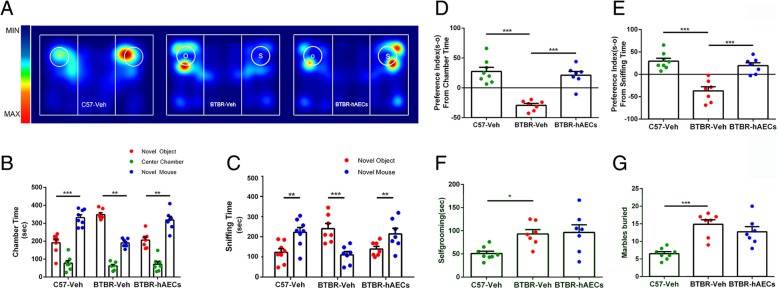Fig. 1.
hAECs reversed social deficits in the three-chambered social test in BTBR mice but did not reduce repetitive behaviors. a Representative heat maps of resting time of BTBR and C57 mice in the sociability chamber. “O” and “S” represent object and mouse, respectively. b C57 mice displayed normal sociability on the chamber time parameter and spent more time in the chamber with the novel mouse compared to the novel object after vehicle treatment. BTBR mice exhibited their lacks of sociability characteristic on the chamber time parameter. However, these social deficits were reversed in BTBR mice with hAEC injection. c The C57 mice treated with vehicle exhibited characteristic sociability on the directed sniffing parameter; BTBR mice after vehicle treatment displayed more interest in the novel object than the novel mouse, but BTBR mice following hAEC injection were more inclined to the novel mouse. d BTBR mice with vehicle injection displayed a lower reference index (S − O/total) compared to C57 mice in chamber time. After hAEC injection, the preference index (S − O/total) was increased in BTBR mice. e BTBR mice showed a lower preference index (S − O/total) in sniffing time compared to C57 mice, and hAEC injection improved the impaired sociability by increasing the preference index (S − O/total) in sniffing time. f BTBR mice displayed normally high levels of self-grooming compared to C57 mice; hAECs could not reduce self-grooming for BTBR mice. g BTBR mice buried more marbles than C57 mice, and BTBR mice treated with vehicle or hAECs showed no difference in marble burying. The data are presented as the mean ± SEM (n = 7–8). *P < 0.05, **P < 0.01, ***P < 0.001

